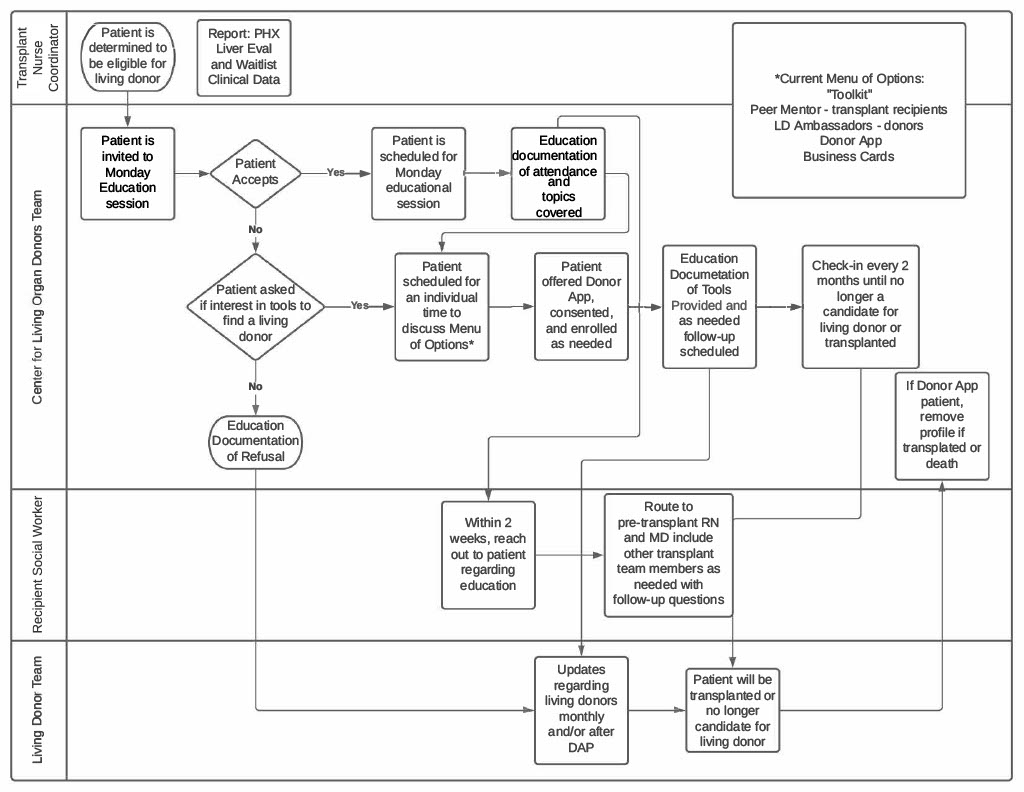Creating a Workflow for the Electronic Medical Record Allows Living Donor Liver Transplantation Programs to Track Candidates and Identify Areas for Optimization
1Yale University School of Medicine, New Haven, CT, 2Yale New Haven Hospital, New Haven, CT
Meeting: 2022 American Transplant Congress
Abstract number: 138
Keywords: Liver transplantation, Living donor, Monitoring, Resource utilization
Topic: Clinical Science » Liver » 58 - Liver: Living Donor Liver Transplant and Partial Grafts
Session Information
Session Name: Surgery innovative Techniques Including Living Donor
Session Type: Rapid Fire Oral Abstract
Date: Sunday, June 5, 2022
Session Time: 5:30pm-7:00pm
 Presentation Time: 6:40pm-6:50pm
Presentation Time: 6:40pm-6:50pm
Location: Hynes Room 313
*Purpose: To provide a pathway to increase living donor liver transplantation (LDLT) opportunities through creation of a simple workflow algorithm embedded within the EPIC electronic medical record (EMR) to track patients and identify barriers and strategies for improvement.
*Methods: A formalized workflow, incorporating specialized EPIC EMR reporting and documentation tools, was developed for identification of candidates eligible for LDLT and monitoring their flow through an education and engagement program that included use of DONOR1 app. This was ultimately linked to donor inquiry data tracking (Figure 1). Reports were analyzed to observe participation and impact of the programs.
*Results: In November 2021, 71 (62.3%) of 114 liver waitlist registrants were eligible to receive a LDLT. Of these 71 candidates, only 27 (38%) attended an intensive evening education program. A total of 32 (45.1%) were interested in taking action to find a living donor and consented to the donor app, however only 15 of these 32 went on to create and publish a post. Only 10% of eligible candidates ultimately had a potential donor come forward.
*Conclusions: Transplant centers performing LDLT can utilize an EMR embedded workflow to identify center activities surrounding opportunities for candidates to obtain a living donor. Despite offering a very comprehensive education program and a software application to aid in identification of potential donors there are barriers to candidates both receiving the education and taking action. This process of workflow analysis permits transplant programs to review clinical variables, social determinants of health, and patient preference for utilization of offered resources, thereby enabling the creation of more targeted education and support efforts to maximize LDLT opportunities across the entirety of their liver waitlist.
1https://www.thedonorapp.com/en/
To cite this abstract in AMA style:
Liapakis A, Batra R, Cohen E, Haakinson D, Schilsky M, Ventura K, Mulligan D. Creating a Workflow for the Electronic Medical Record Allows Living Donor Liver Transplantation Programs to Track Candidates and Identify Areas for Optimization [abstract]. Am J Transplant. 2022; 22 (suppl 3). https://atcmeetingabstracts.com/abstract/creating-a-workflow-for-the-electronic-medical-record-allows-living-donor-liver-transplantation-programs-to-track-candidates-and-identify-areas-for-optimization/. Accessed November 18, 2025.« Back to 2022 American Transplant Congress

